Photographs: Courtesy, Nestle Ranju Sarkar in New Delhi
The foods major has moved to higher price points even though a similar strategy flopped last year. Will it be second time lucky?.
Last month, when Nestle India raised the prices of its chocolates and Maggi noodles, the market was watching closely.
The subsidiary of Swiss food major Nestle SA moved away from the traditional price points of Rs 2, Rs 5 and Rs 10. Instead, it started experimenting with price points of Rs 7, Rs 12 and Rs 14 in KitKat and plans to replicate the same with Maggi.
Many analysts are not sure whether Nestle would be able to sustain the price hike, given that it had to roll back a similar increase last year after volumes took a hit.
. . .
Nestle: Once bitten, but not shy
Image: Nestle office.Nestle has done so to protect its margins in view of the sharp rise in input costs, but analysts say the company is perhaps trying to move away from volume growth in KitKat and Maggi by moving away from lower price points.
But Nestle doesn't buy this argument. 'We continue to drive volume growth but have to ensure that it is profitable and sustainable. Cost pressures have been unprecedented,'' says a Nestle executive.
That flies against the conventional wisdom that lower price points of Rs 1, Rs 2, Rs 5 and Rs 10 help consumer goods companies add new consumers and drive volumes.
Analysts say volumes may get impacted for one or two quarters, but will come back to normal.
. . .
Nestle: Once bitten, but not shy
''If milk prices go up 25-30 per cent, how long can a company keep with it? If volume growth suffers, it will have to live with it. You cannot see profitability shrinking by 200-300 basis points every year and then talk about growth,'' says Manish Jain of Nomura Financial Advisory and Securities.
There could be some slowdown in the category, which has been growing at 12-14 per cent.
KitKat, which was earlier sold at popular price points of Rs 5 and Rs 10, is now being sold at price points of Rs 7 and Rs 14, respectively.
. . .
Nestle: Once bitten, but not shy
Image: Farmers in Moga, Punjab.Photographs: Courtesy, Nestle
Analysts say Maggi is set to follow suit.
In some variants of Maggi, Nestle has already moved up from Rs 10 to Rs 12.
Nestle's new price points may be a big risk, given that Cadbury, its competitor in chocolates, is still present in the Rs 2, Rs 3 and Rs 5 price points.
This is because of past experience.
When Cadbury introduced products at popular price points of Rs 2, Rs 3 and Rs 5 last year, Nestle went against the grain and raised prices of KitKat from Rs 5 to Rs 6 and from Rs 10 to Rs 12, only to roll back the price hikes when it saw volumes dip (not known how much volumes fell). So what has changed this time?
. . .
Nestle: Once bitten, but not shy
''Price points are important and we continue to be present at the ones that are relevant. We had increased the prices for the two-finger KitKat and four-finger KitKat to Rs 6 and Rs 12 respectively and also introduced new formats of one-finger at Rs 5 and three-finger at Rs 10 to be also available at the relevant price points," a Nestle official says, adding price points are not the only criteria for consumers. .
Analysts say lower price points are more relevant for Cadbury, which is a much bigger brand in chocolates than Nestle which is only into wafer and white chocolates and has built its franchise on coinage.
. . .
Nestle: Once bitten, but not shy
'Cadbury has a huge brand loyalty and hence it is a different ballgame. It needs to be present across price points. Nestle is a much smaller player in that sense,'' says Jain.
For Nestle, confectionaries account for just 14 per cent of its sales, and it is not just dependent on chocolates,'' says another FMCG analyst with a broking house, who didn't want to be quoted.
Analysts feel the first impact of the price hike may come at the retailer level, who could resist stocking KitKat, and the second-level of resistance could come at the consumer level.
. . .
Nestle: Once bitten, but not shy
Image: Courtesy, NestleThey say even if volumes dip marginally, it is no cause for worrry.
'Nestle is not shifting from its core volume growth but the price hike is more a function of input cost. It works on a margin band of 19-21 per cent EBITDA, and may have a threshold for each category,'' says Manoj Menon, FMCG analyst with Kotak Securities.
For instance, the company stopped supplying to the Canteen Store Department, which shows the company is not willing to sacrifice profits for volumes.
Analysts point out an interesting aspect: Nestle never had to face competition in India. In all categories, they are either a monopoly or a duopoly.
. . .
Nestle: Once bitten, but not shy
Image: Courtesy, NestleIn nutritional products, it enjoys 90 per cent market share.
In culinary products, it enjoyed close to 90 per cent market share, with just one rival in Top Ramen for years.
But Nestle's real test will come in the next couple of years when competitors establish themselves.
All the products are priced similar but are trying to have different positioning. Knorr is positioning as soups + noodles; Glaxo is saying its good for you; ITC has positioned its product as non-sticky noodles.
That's something Nestle's Maggi needs to watch carefully.

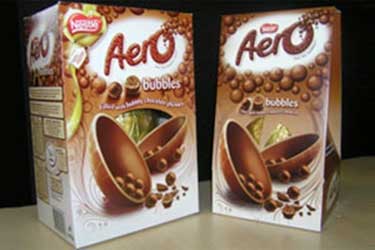


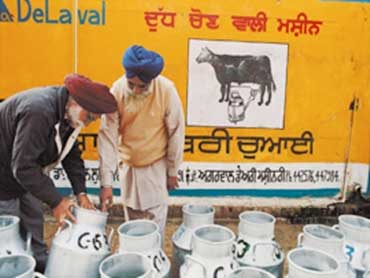
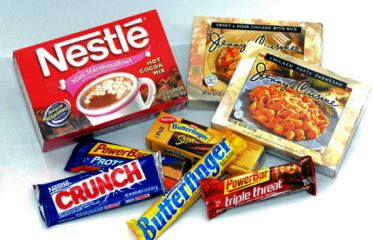

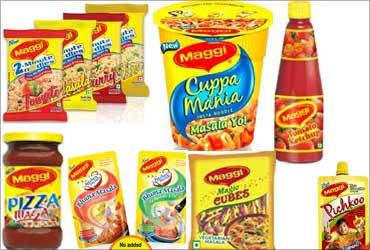
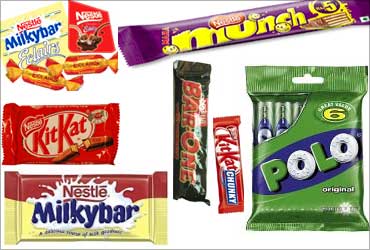

article